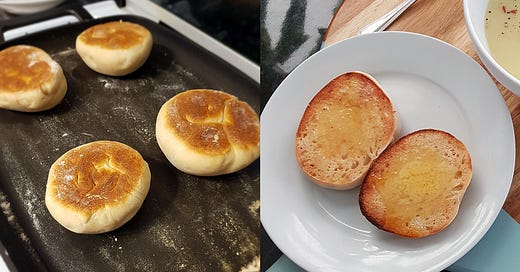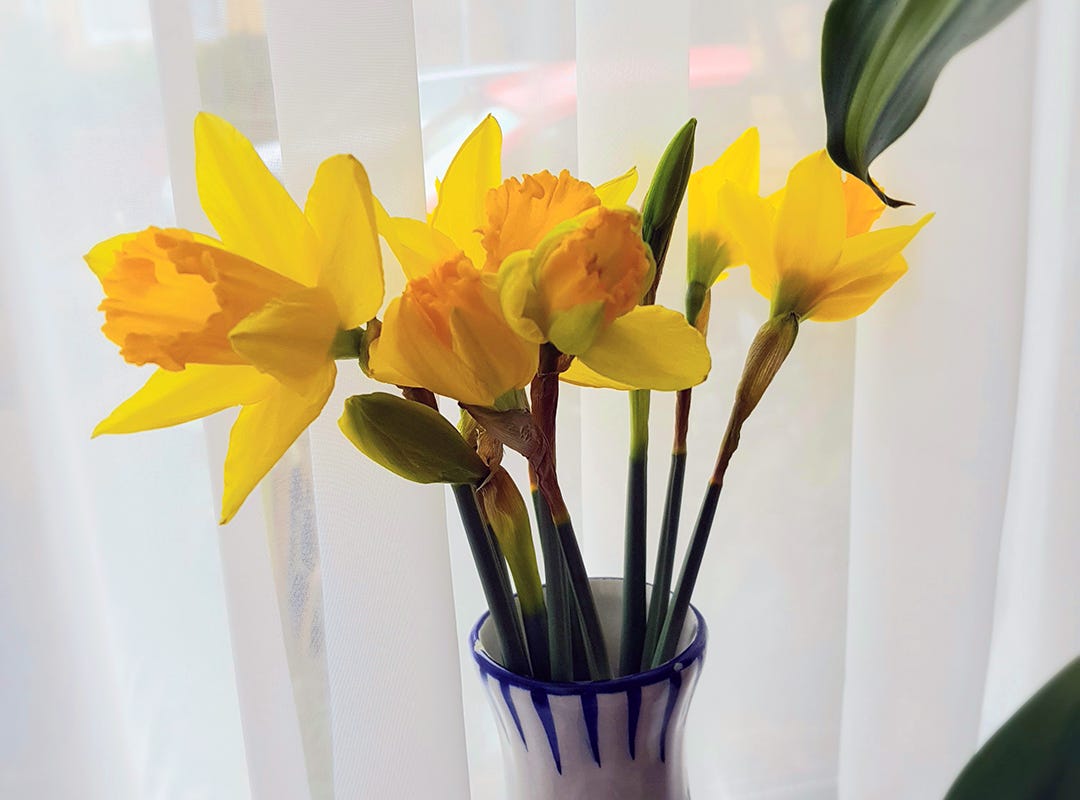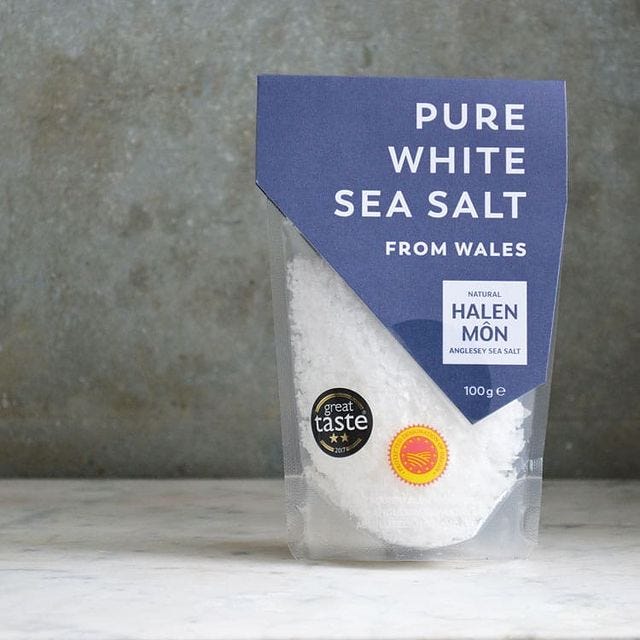I’m sitting at my desk and it’s raining. No great shocker for winter in Wales I know, but thankfully I have a treat on the windowsill. A vase of beautiful bright yellow daffodils that is currently making the endless days of lockdown inside a bit more joyous. It seems to be getting earlier every year that the daffodils start to peek out from the soil. This year, I saw my first ones before Christmas out on a walk in the local countryside. Typically, daffs are a spring flower, showing their sunshine trumpets from late February when the snow starts to melt on the hills and mountains, through until May when sunny bank holiday weekends can be spent by the coast. And of course, they are a glorious part of Welsh life.
Talking of Welsh life, I cannot wait to enjoy walks again at St Fagans (St Fagans National Museum of History to give it its new proper name). For those who are unfamiliar with the museum, it’s a free-to-enter open-air ‘village’ of meticulously reconstructed buildings from all over Wales from various parts of its history, from Celtic huts to prefabs, workingmen’s institutes to chapels, and documents the life and culture of the people of Wales through the ages.
One of my favourite parts (and there are many) is Rhyd-y-car Terrace – a small row of six houses built in 1795 for the workers of an iron-ore mine in Merthyr Tydfil. The houses (rebuilt at the museum in 1982/83) now show the row – and the lifestyles of its inhabitants – at six different periods of their history, from1805 to 1985. On the end of the row you’ll find a whitewashed building with a small opening. This is a communal oven. The houses’ facilities back in the early 1800s would have been limited and so these large ovens where built for the entire street to use, with each family having an allocated day of the week to bake bread. The question is of course, what do you do on the other six days without an oven? Well, you mainly use a bakestone.
Bakestone cookery goes back to celtic times and Wales is one of the few places where the tradition has remained somewhat alive. A quick poll of my friends in their 20s and 30s know of or own a bakestone – even if they’ve never used one. Originally, they were made of (you guessed it) stone and were placed over an open fire to heat up. Fast forward a couple of hundred years and you get steel and cast iron ‘stones’ placed on the hob.
The most common use of the bakestone these days is to cook Welsh cakes (Pice ar y maen in Welsh – literally ‘cakes from/on the stone’), but there are so many more things you can cook – as those inhabitants of Rhyd-y-car Terrace well knew – including pancakes, pikelets, oatcakes and even bread (more on this below!). I have a bakestone made by my grandfather when he worked at the steelworks, but these days I cheat a little and use a thick flat non-stick griddle that has a handy lip around the edge allowing me to cook everything from steak to fried eggs, fish to toasties. I don’t think I do without it in the kitchen now.
Classic round bakestones are relatively inexpensive to buy but will last you a lifetime with good care. Don’t forget to ‘feed’ it when you first buy it by greasing it and always start on a low heat and bring up to temperature.
The Recipe
Bara planc – Bakestone bread
As I mentioned above, the bakestone was used during the week to make small baked goods and very ingenious cooks realised you could in fact even bake bread on it. I have tried several times and all I can say is that they must have been very skilled cooks. Bara planc is a round flat loaf with a crusty top and base and soft sides and centre but notoriously tricky to get to rise evenly. That said, bara planc rolls are relatively easy to get right and one of my favourite ways to make use of the bakestone.
They look a bit like English muffins but they have a wonderful crunchy crust and are ideal for burger buns (I am not a fan of sickly sweet brioche for burgers), in place of muffins for eggs Benedict (lovely with Carmarthen ham), or simply toasted and buttered to dip in soup.
Ingredients (makes 8 rolls)
500g plain flour (not bread flour)
7.5g dried fast-action yeast (one sachet)
1tsp fine sea salt
1tsp caster sugar
250ml milk at room temperature
50ml water from a recently boiled kettle
Olive oil for greasing
Method
Sift the flour into a large bowl and stir in the yeast, salt and sugar.
Add the water to the milk and tip both into the bowl.
Mix together with a wooden spoon or your hands until a rough dough is formed (add more water if needed).
Splash a little olive oil on the worktop, tip the dough onto it an knead for around 10 minutes until smooth.
Lightly oil a large clean bowl and place the kneaded dough in. Cover with cling, a damp tea towel (or a showercap à la Nigella) and leave in a warm place for an hour and a half to nearly double in size.
Tip the dough onto a lightly floured surface and knock back.
Roll into a cylindrical shape and divide into eight pieces.
Roll each piece into a smooth ball and then flatten into 2cm-thick discs.
Leave to relax while you bring your bakestone up to a medium/low heat.
When the bakestone is ready (around 10-15 minutes), pop the rolls on. You should be able to fit four at a time on a classic round bakestone.
Cook for a about 20 minutes until they have risen to double their thickness and the base is nicely browned.
Gently flip over and cook for a further 15-20 minutes. If they look like they’ve deflated when you turn then over, don’t worry, they should puff back up again.
Allow to cool on a wire rack and store as you would bread and rolls. They keep for about a week.
I love the magic of these rolls, as just when you think all is lost, they start to rise. Pure satisfying baking bliss.
If you try it out, don’t forget to tag any photos with #mywelshkitchen
The Playlist
To me, cooking and music go hand in hand, whether that’s singing at the top of your voice using a wooden spoon as a microphone while waiting for pasta to boil, or dancing around with the oven gloves on as the oven timer counts down. Here are this week’s ideas for your Welsh Kitchen playlist.
This week we have an absolute classic from Pontardawe’s own Mary Hopkin, and a song in the Cornish language from Cardiff-born musician Gwenno.
Those Were The Days by Mary Hopkin
Tir Ha Mor by Gwenno
The Pantry
Good food is nothing without good ingredients and thankfully there are plenty of fantastic Welsh products on the market. Here is where you’ll find recommendations to stock up your cupboard, fridge or fruit bowl.
Halen Môn
I’ll be honest, I never really got it. Salt was just something that either went on top of fish and chips and came from a small pear-shaped glass shaker with the white plastic nozzle or was shaken liberally into pans of boiling Sunday dinner veg from a fat, red cylindrical Saxa tub. While there’s something great about table salt on my tastebuds, I have come to appreciate good quality sea salt flakes. They have a different, well… saltiness and enliven even the most bland dishes. Sprinkled on a boiled egg, avocado on toast, or chocolate mousse, you get that slight satisfying crunch and the soft tingle of the sea. And when it comes to salt flakes, Halen Môn has me covered with their carefully collected salt from the waters that surround Anglesey. Their little pinch pots are ideal for popping in your bag to liven up food on-the-go or even as stocking fillers.






